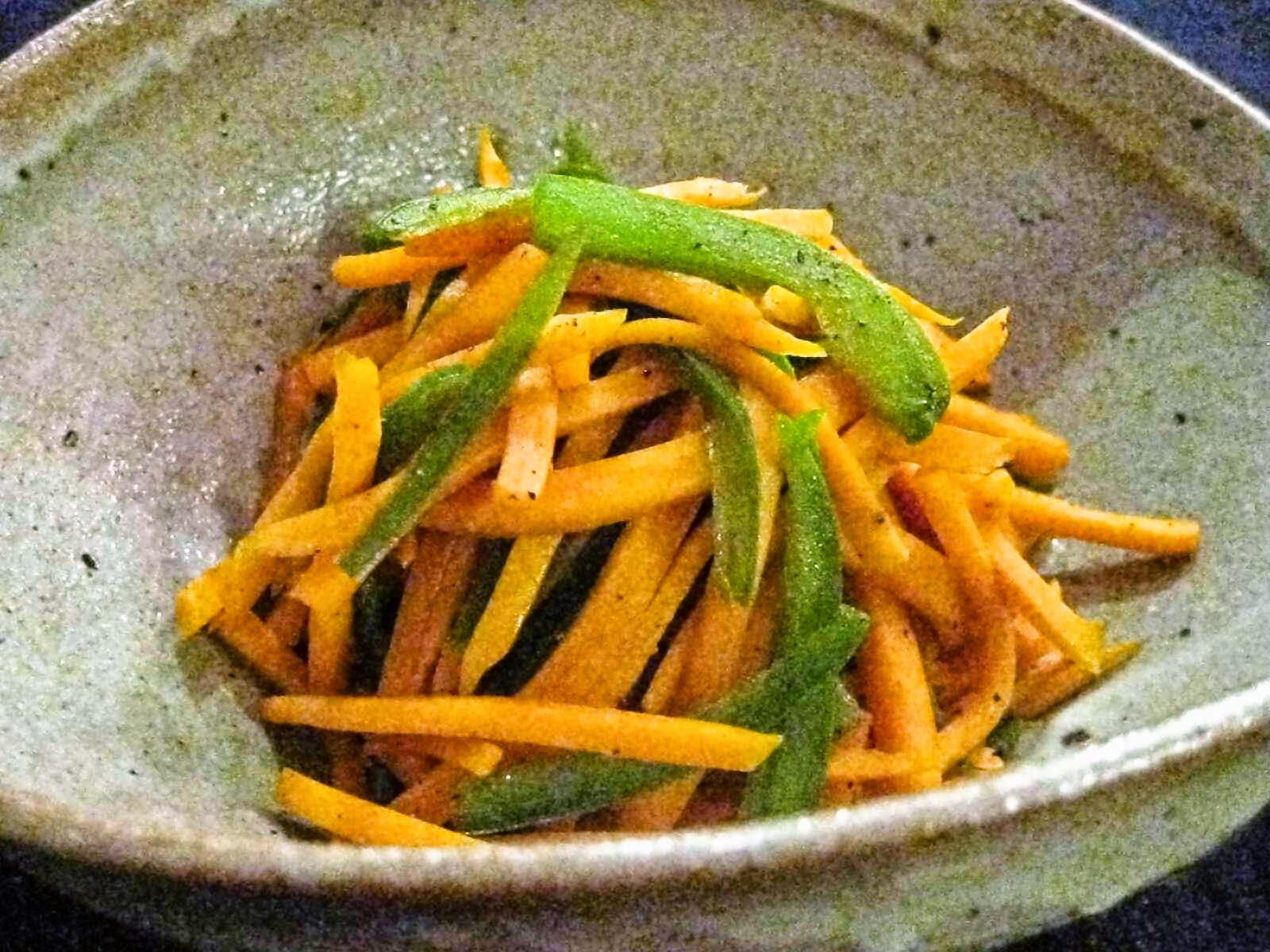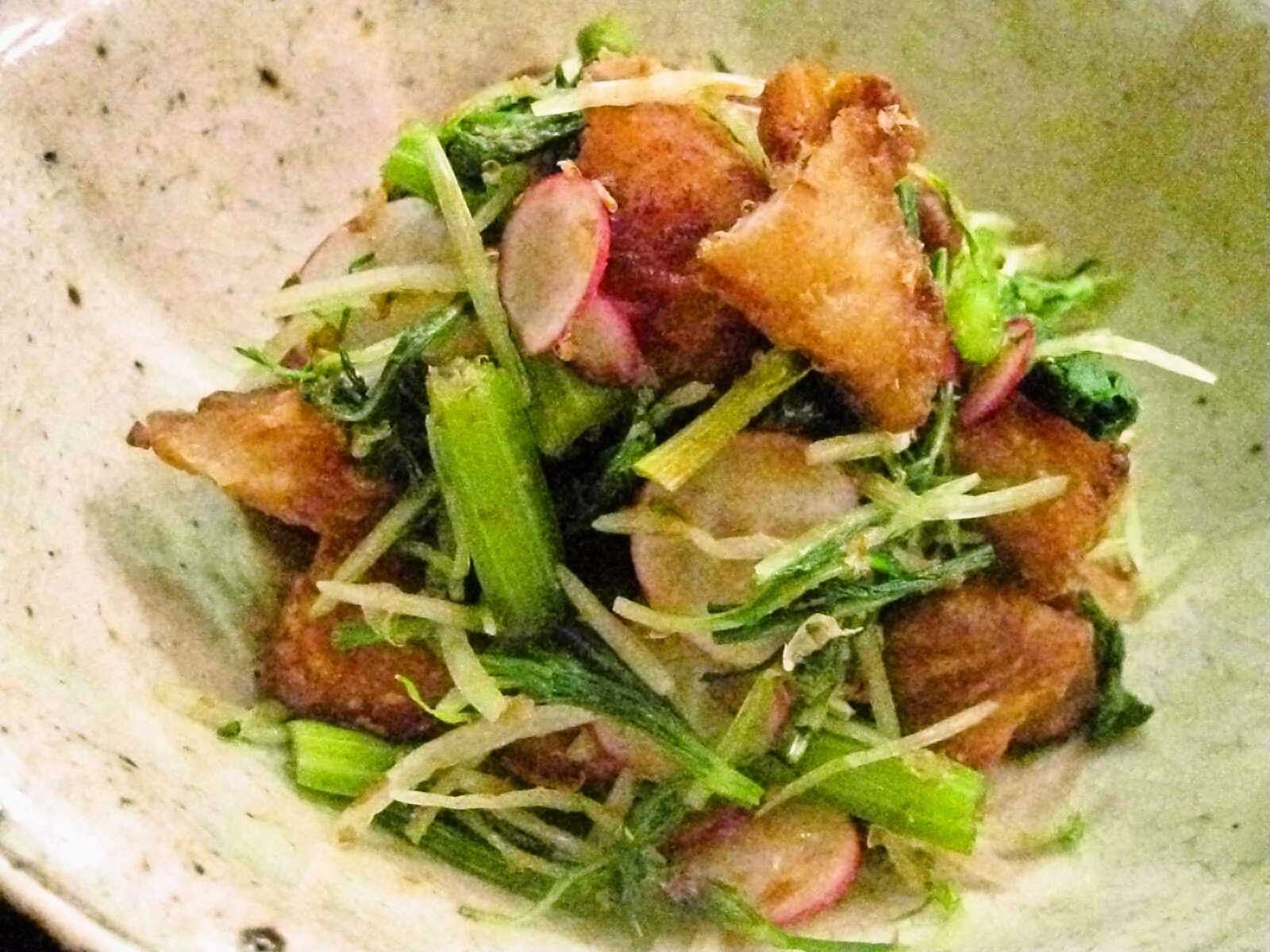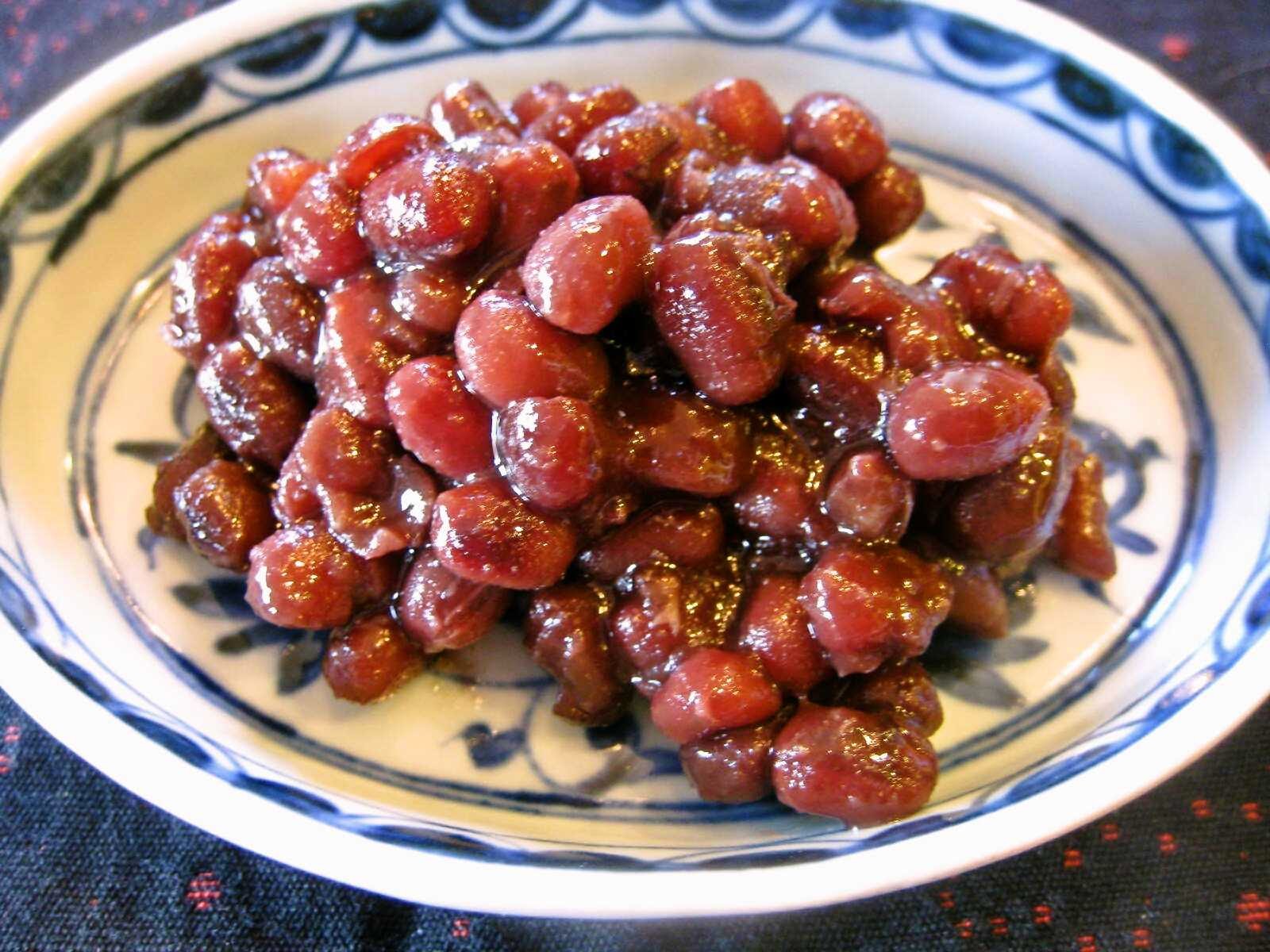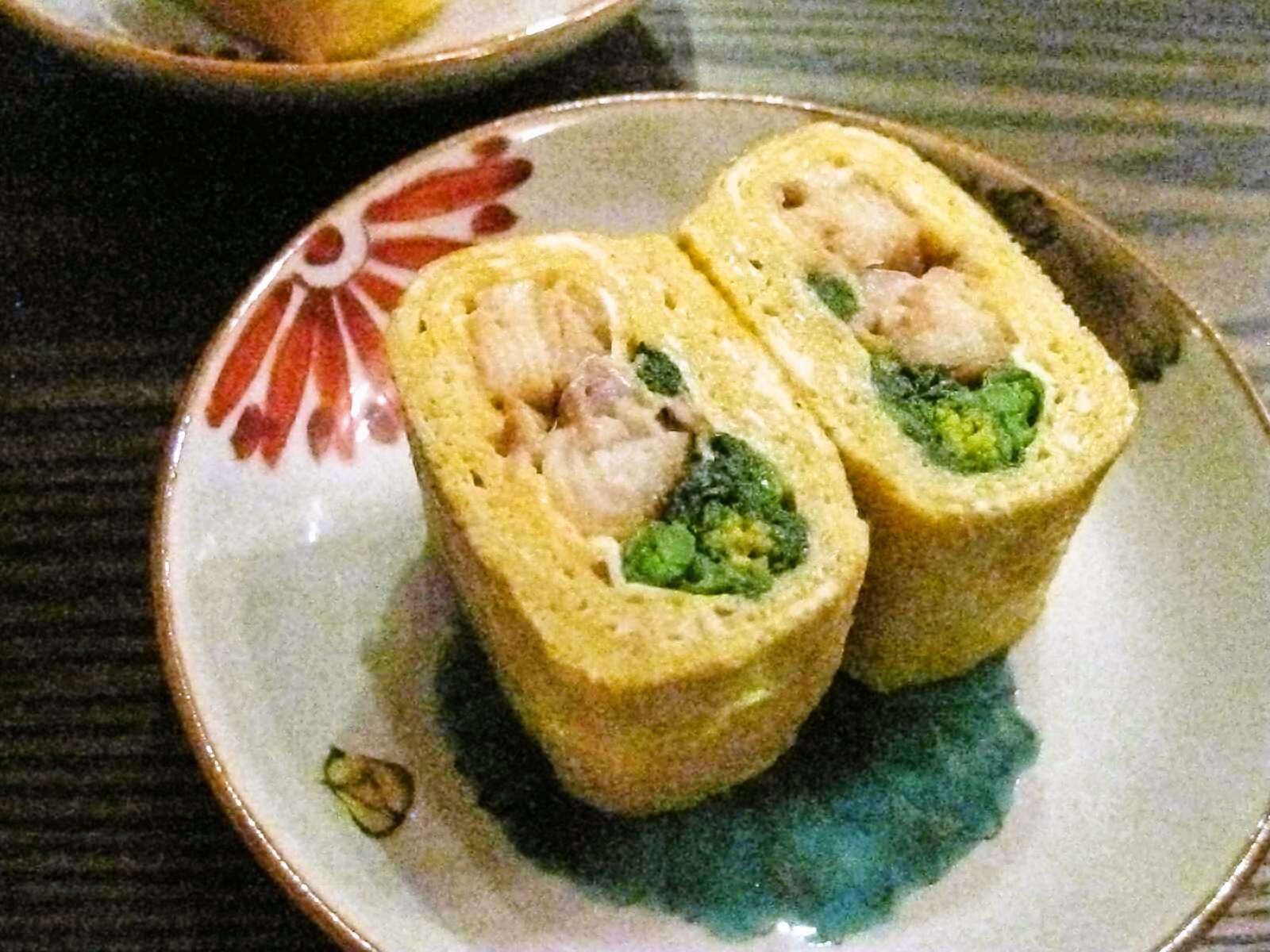All recipes are for 2 servings unless noted. Oil is canola oil and salt is kosher salt.
2013-03-28
Hikozuri / bamboo shoot saute with sweetened miso
A regional specialty of Kumamoto in southern Japan. A small amount of ground sesame seed is the secret ingredient in the miso sauce.
Labels:
1 very easy,
10 min,
bento,
picnic,
Recipes - Japanese,
saute,
takenoko,
vegetables
2013-03-27
Biitsu no amazuzuke / beet marinated in sweetened rice vinegar
Labels:
1 very easy,
10 min,
beets,
bento,
make ahead,
marinate,
pickles,
picnic,
Recipes - Japanese,
reduced sodium,
vegetables
2013-03-26
Niratama misoshiru / miso soup with garlic chives and egg
Labels:
1 very easy,
10 min,
eggs,
nira,
Recipes - Japanese,
simmer,
soup,
vegetables
2013-03-25
Yamu to harapenyo no itamemono / yam and jalapeno pepper saute with oyster sauce
A bit sweet and slightly spicy. Yam and oyster sauce contribute to the sweetness, while sauteed jalapeño pepper adds a softly spicy tingle.
Labels:
1 very easy,
10 min,
bento,
jalapeno pepper,
picnic,
Recipes - Chinese,
saute,
stir-fry,
vegetables,
yam
2013-03-24
Tom Cooks 10: Kaki furai (panko deep-fried oysters)
Our fridge is usually filled with fresh ingredients, and those that stay good longer sometimes get neglected.
A jar of oysters had been sitting in the fridge for some time. Tom strategically put it at the very front of a shelf right at eye height, and he repeatedly mentioned that he wanted to eat kaki furai.
I listened, but there was always something else that caught my attention rather than the still-good oysters. Then I got busy with work – for days I was glued to my computer editing a 50,000-word translation.
And so, desperate, Tom made kaki furai himself.
Finally, he actually tried my instructions on how to make a non-greasy deep-fried dish, and carefully adjusted the oil temperature and what-not.
A jar of oysters had been sitting in the fridge for some time. Tom strategically put it at the very front of a shelf right at eye height, and he repeatedly mentioned that he wanted to eat kaki furai.
I listened, but there was always something else that caught my attention rather than the still-good oysters. Then I got busy with work – for days I was glued to my computer editing a 50,000-word translation.
And so, desperate, Tom made kaki furai himself.
Finally, he actually tried my instructions on how to make a non-greasy deep-fried dish, and carefully adjusted the oil temperature and what-not.
2013-03-22
Tsuruna no sujoyu-ae / New Zealand spinach in vinegar soy sauce
A quick dish of succulent New Zealand spinach with a spicy tobanjan twist. The vinegar in the dressing makes this a refreshing companion for all sorts of dishes, including those with strong flavors.
Labels:
1 very easy,
10 min,
bento,
blanch,
picnic,
Recipes - Chinese,
Recipes - Japanese,
tsuruna,
vegetables
2013-03-20
Takenoko to sakura ebi no itamemono / bamboo shoot saute with sakura ebi dried shrimp
Thinly sliced bamboo shoot is pleasantly light in texture, while sakura ebi provide a toasty note. An easy little side dish.
Labels:
1 very easy,
10 min,
bento,
picnic,
Recipes - Japanese,
sakura ebi,
saute,
stir-fry,
takenoko,
vegetables
2013-03-19
Nasu to kobashira no XO-jan itame / eggplant and bay scallops in XO sauce
This popular combination of eggplant and scallops with XO sauce is always a taste treat. Oil-loving eggplant is deep-fried for a pretty dark purple skin color and creamy texture -- but you will be surprised at how “ungreasy” this dish is. Great with drinks, plain steamed rice or Chinese rice porridge.
Labels:
3 moderate,
30 min,
bay scallops,
bento,
deep-fry,
eggplant,
nasu,
picnic,
Recipes - Chinese,
saute,
seafood,
vegetables
2013-03-16
Karei no sotee, horenso-an-kake / sauteed sole with thickened spinach sauce
Labels:
2 easy,
30 min,
blanch,
fish,
karei,
Recipes - Japanese,
saute,
seafood,
simmer,
spinach,
vegetables
2013-03-15
Tomato to enoki no sanraatan / suan la tang hot and sour soup with tomatoes and enoki mushrooms
Substantial and refreshing. With a boost from a dried scallop, this hot and sour soup offers lots of flavor and aroma. Great with somewhat heavy dishes, too.
Labels:
2 easy,
30 min,
cilantro,
dried scallops,
enoki,
rayu,
Recipes - Chinese,
rice vinegar,
soup,
takenoko,
tofu,
tomatoes,
vegetables
2013-03-14
Yamu no amakarani / sweet and salty simmered yam
One of the standard flavorings for potatoes and sweet potatoes. A small amount of strong-flavored sweet yam is a good companion for any meal. Tom’s kind of dish.
Labels:
1 very easy,
30 min,
bento,
picnic,
Recipes - Japanese,
simmer,
vegetables,
yam
2013-03-13
Karifurawaa to burokkorii no shiokoji tamago sarada, kochujan-fumi / cauliflower and broccoli with hard-boiled egg marinated in salted rice malt, and gochujang
A simple salad with egg-based dressing. A small amount of olive oil helps to make it a bit more creamy, and gochujang Korean pepper paste adds a spicy yet somewhat sweet note. Using a hard-boiled egg marinated in salted rice malt eliminates the need to use mayonnaise, so this rich dressing has a very light aftertaste.
Labels:
1 very easy,
10 min,
bento,
blanch,
broccoli,
cauliflower,
eggs,
picnic,
Recipes - Japanese,
salad,
shiokoji tamago,
vegetables
2013-03-12
Shiokoji tamago / hard-boiled eggs marinated in salted rice malt
Just wait for a week … the eggs take on a mayonnaise taste all by themselves! A great substitute for recipes using eggs and mayonnaise.
2013-03-11
Sakana no karashiage to kinsai, mizuna, radisshu no aemono / karashi mustard-flavored deep-fried fish and Chinese celery, mizuna and radish
Deep-fried fish marinated in karashi mustard is tasty on its own, as is Chinese celery, mizuna and radish with bonito flakes and a tiny bit of soy sauce. When combined, you have a satisfying yet refreshing fish & vegetable dish!
Labels:
3 moderate,
30 min,
blanch,
deep-fry,
fish,
karashi,
katsuobushi,
kinsai,
mizuna,
radish,
Recipes - Japanese,
seafood,
vegetables
2013-03-10
Sakura no ha no shiozuke / salted cherry leaves
When salted, cherry leaves develop a unique tangy aroma and taste. Salted cherry leaves are an ingredient -- often used as a wrapper -- in confectioneries and meals that are especially popular in springtime. For commercial producers, Oshimazakura (Cerasus speciosa [Koidz.] H.Ohba) is the flowering cherry tree of choice for leaves, as Oshimazakura’s leaves are known for their tenderness. However, you can use the leaves of any cherry tree (so far I have only tried flowering cherry trees).
2013-03-09
Sakuramochi (Chomeiji) / sweet azuki paste cake in cherry leaves (Tokyo style)
Wrapped in aromatic cherry leaves, this is a salty-sweet and tasty confectionery. The crepes made of flour and sweet rice powder are normally pan-fried, but microwaving makes it so easy and quick – and oil-free!
Labels:
120 min (2 hrs),
2 easy,
azuki,
microwave,
Recipes - Japanese,
snack,
sweets,
tsubuan
2013-03-08
Tsubuan / sweetened crumbly azuki bean paste
A typical sweetened azuki bean paste for a number of Japanese sweets. Pre-made bean paste from store shelves is handy but has a clear sugar taste rather than bean's natural sweetness. Making your own bean paste takes some time, but it’s definitely worth the effort. Use a thick-walled pot for best results.
2013-03-07
Yakipiiman no shogajoyu-ae / grilled peppers in ginger soy sauce
Labels:
1 very easy,
10 min,
bento,
ginger,
green peppers,
grill,
paprika,
picnic,
piiman,
Recipes - Japanese
2013-03-05
Sakana to saishin no tamagoyaki / omelet with fish and yu choy sum
Everyday tamagoyaki omelet dressed-up from the inside. This will make your table look a bit special, too.
Labels:
3 moderate,
30 min,
bento,
blanch,
eggs,
fish,
marinate,
pan-fry,
picnic,
Recipes - Japanese,
seafood,
vegetables,
yu choy sum
2013-03-04
Atsuage to takenoko no misoni / deep-fried tofu and bamboo shoots in miso-flavored broth
This softly salty miso broth is wonderful with takenoko. Oil from atsuage adds just enough of a rich note to the broth.
Labels:
1 very easy,
30 min,
atsuage,
Recipes - Japanese,
simmer,
takenoko
2013-03-03
Takenoko no mizuni / bamboo shoot prep-boiling
Bamboo shoots are the taste of spring. While boiled bamboo shoots are available in vacuum packs, cans and in open bins at Japanese grocery sections or stores, boiling fresh bamboo shoots yourself rewards you with the taste and aroma of the season.
Fresh bamboo shoots are encased in a tough skin, but there is no need to feel intimidated. The skin is simply protecting the jewel inside that awaits.
Fresh bamboo shoots are encased in a tough skin, but there is no need to feel intimidated. The skin is simply protecting the jewel inside that awaits.
Subscribe to:
Posts (Atom)



















